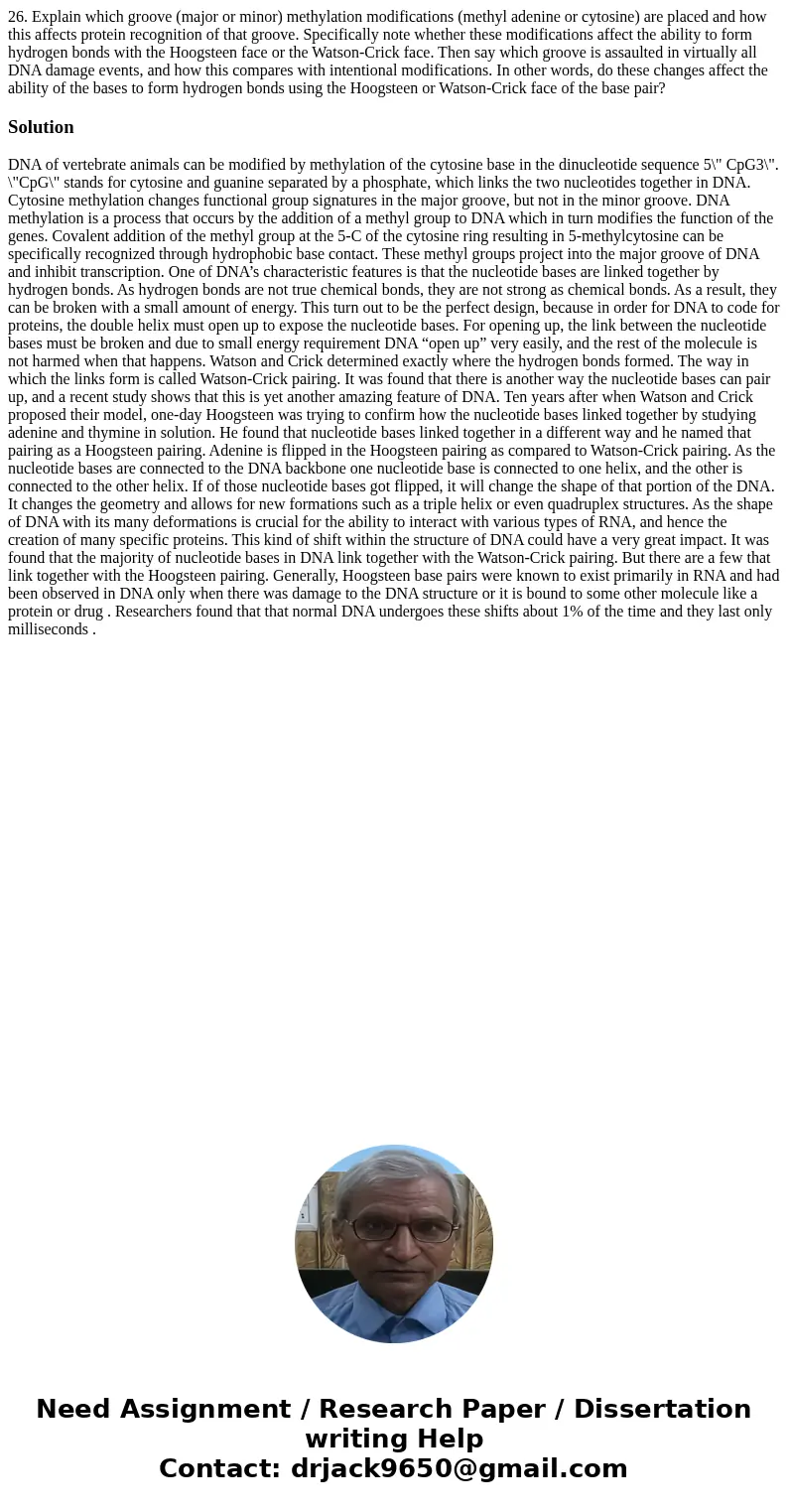26 Explain which groove major or minor methylation modificat
26. Explain which groove (major or minor) methylation modifications (methyl adenine or cytosine) are placed and how this affects protein recognition of that groove. Specifically note whether these modifications affect the ability to form hydrogen bonds with the Hoogsteen face or the Watson-Crick face. Then say which groove is assaulted in virtually all DNA damage events, and how this compares with intentional modifications. In other words, do these changes affect the ability of the bases to form hydrogen bonds using the Hoogsteen or Watson-Crick face of the base pair?
Solution
DNA of vertebrate animals can be modified by methylation of the cytosine base in the dinucleotide sequence 5\" CpG3\". \"CpG\" stands for cytosine and guanine separated by a phosphate, which links the two nucleotides together in DNA. Cytosine methylation changes functional group signatures in the major groove, but not in the minor groove. DNA methylation is a process that occurs by the addition of a methyl group to DNA which in turn modifies the function of the genes. Covalent addition of the methyl group at the 5-C of the cytosine ring resulting in 5-methylcytosine can be specifically recognized through hydrophobic base contact. These methyl groups project into the major groove of DNA and inhibit transcription. One of DNA’s characteristic features is that the nucleotide bases are linked together by hydrogen bonds. As hydrogen bonds are not true chemical bonds, they are not strong as chemical bonds. As a result, they can be broken with a small amount of energy. This turn out to be the perfect design, because in order for DNA to code for proteins, the double helix must open up to expose the nucleotide bases. For opening up, the link between the nucleotide bases must be broken and due to small energy requirement DNA “open up” very easily, and the rest of the molecule is not harmed when that happens. Watson and Crick determined exactly where the hydrogen bonds formed. The way in which the links form is called Watson-Crick pairing. It was found that there is another way the nucleotide bases can pair up, and a recent study shows that this is yet another amazing feature of DNA. Ten years after when Watson and Crick proposed their model, one-day Hoogsteen was trying to confirm how the nucleotide bases linked together by studying adenine and thymine in solution. He found that nucleotide bases linked together in a different way and he named that pairing as a Hoogsteen pairing. Adenine is flipped in the Hoogsteen pairing as compared to Watson-Crick pairing. As the nucleotide bases are connected to the DNA backbone one nucleotide base is connected to one helix, and the other is connected to the other helix. If of those nucleotide bases got flipped, it will change the shape of that portion of the DNA. It changes the geometry and allows for new formations such as a triple helix or even quadruplex structures. As the shape of DNA with its many deformations is crucial for the ability to interact with various types of RNA, and hence the creation of many specific proteins. This kind of shift within the structure of DNA could have a very great impact. It was found that the majority of nucleotide bases in DNA link together with the Watson-Crick pairing. But there are a few that link together with the Hoogsteen pairing. Generally, Hoogsteen base pairs were known to exist primarily in RNA and had been observed in DNA only when there was damage to the DNA structure or it is bound to some other molecule like a protein or drug . Researchers found that that normal DNA undergoes these shifts about 1% of the time and they last only milliseconds .
 Homework Sourse
Homework Sourse